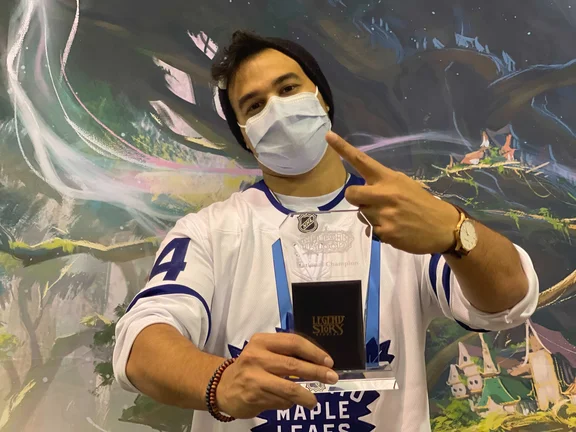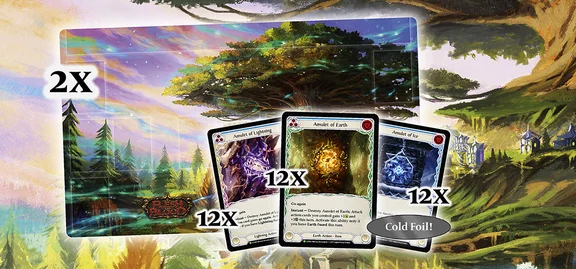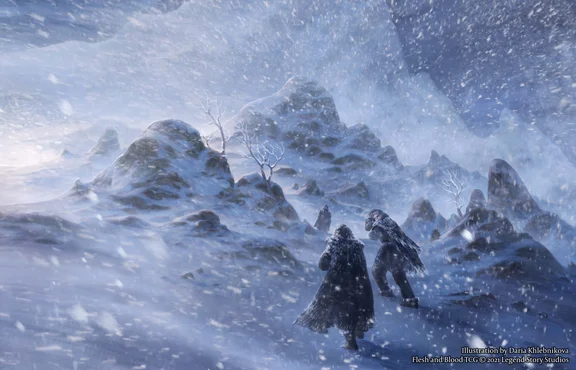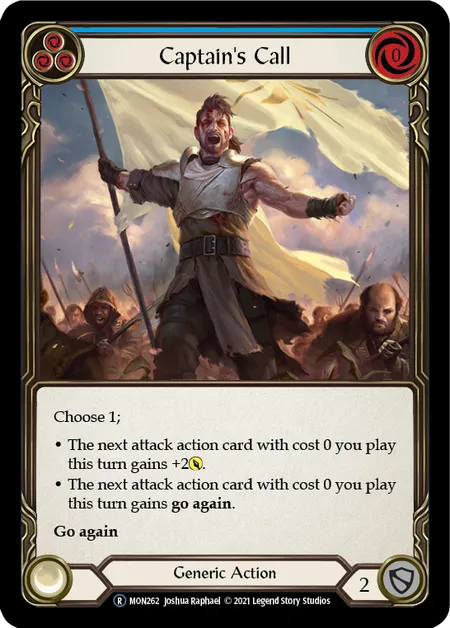After an incredible performance in Orlando, the United States' first National Champion Tariq Patel sat down with me to talk about the art of the game, mastery of play, and playing at the highest possible level.

Tariq's first event was an Armory event in September, where he played with a borrowed deck for just one round before dropping.
'Unfortunately Covid hit really hard in the summer. I work in the hospital so we were kind of pulling double-shifts, so I wasn’t able to learn the game until September, just a couple weeks before the Calling in Las Vegas. At that time you know, it kind of died down a little bit, so I went to my local game store, I met some people who are now my friends and they kind of introduced me to the game.
I first heard about Flesh and Blood when they announced [the Calling] events and the incentives, to bring organized play to more of a competitive level. I found out that the national championship was going to be 20 minutes from my place right here in Orlando, so. I always had the intention of at least going to Dallas, because of the flights, and also because I’m friends with Tannon Grace, and there is incentive to go where a friend was already going to be.'

'After that Armory, I think my next event must have been the Tales of Aria pre-release, and I functionally didn’t know how to play the game. When I actually went, I did not even know what the heroes did. I kind of like, joined the event, and I sorted my cards and I'm like ‘great, now what do my heroes do.’ Somebody was like ‘you're supposed to know that before you come to the event!’ That was really my first real event I would say, and then from there - being obsessive, I kind of broke down the formats very systematically. I broke it down by each card by each synergy and each strength, and then very next week I showed up to my locals, drafted, and learned the game from there.
A lot of my testing actually ended up being that I would just play against myself, and I would sit at my computer with a physical deck and a digital version of the deck I wanted to test, and I would just play against myself, and learn the nuances through proper play. At first it was very slow cuz I wouldn't know what anything did, and I just taught myself “okay this is what this deck does, and that’s what this deck does,” and just slowly over time you learn, so I got better and better.'
Tariq is one of the most methodical players I've spoken with to date, not only spending hours playtesting various heroes by himself to learn the matchups and the styles of each deck, but making spreadsheets of data to analyse each card and how it could play into a larger strategy.
'I organized a bunch of local drafts with people who wanted to practice for Dallas, picked up the format, learnt it pretty well. I ended up in ninth at Dallas, and all my friends kind of convinced me that I had to do it again in Cincinnati, cuz at that time I wasn't booked. So I booked a last minute flight out to Cincinnati, ended up getting second there; in the meantime I was working on Classic Constructed in that month.
So in terms of preparation, you know, you always learn in life, you make mistakes and you learn for the next time. So I made mistakes just like any normal human would at Dallas, and I took those lessons away. I think beating Matt Rogers in Dallas, and then we did a private draft too, I think Friday night… it kind of boosted my confidence a lot, because going in you know everybody knows he was number one in the world, and the fact that my own knowledge that I kind of came to independently was validated when I compared it to his, it kind of gave me the confidence boost to be like “okay, so a lot of the ideas I arrived at independently, people who have been playing this game a lot longer have also come to the same conclusions, so I must be doing the right thing.” Or- not just doing the right things, but the process of what I’m doing must be working. So I kind of just kept doing what I was doing.
I'm a very much a process person, like I never go into an event thinking “oh, I’m going to top 8 this”, that was never my intention in Dallas, Cincinnati, or Nationals. I just kind of believe in putting in the work. You know, I have spreadsheets of data that I kind of derived for myself, you put in the time, you put in the effort, and at the actual event I just tried to not make a mistake and play my best. I think Cincinnati, I could count on one hand the amount of plays that I would take back. Nationals as well, I think that all of my hard work and preparation I did carried me through both events.'

Some may not know that Tariq was the origin of the zero-cost "cheerios" Briar deck, something he'd been playtesting ahead of the Calling: Dallas Fort-Worth.
' Originally, when I made that deck, I gave it to like two people. I wasn’t egotistical enough to think that I’d created something really amazing like a week or two after playing the game. So I'm like ‘here's the deck, what do y'all think?’ And they were sitting there like ‘holy crap, this is really good’, and it kind of… one person tells one person, who tells one person; it kind of has that tree effect, and it got out. So when I was playing my match in Cincinnati, they had the PTI event on the other feature table, and I hear Chris Higashi go ‘Captain’s Call blue into Nimblism’. I was like ‘who else plays Captain’s Call blue-?’ So I went over to him and said “just out of curiosity… interesting cards that you're playing there, where'd you come up with the idea?” And he said “oh, I got it from so-and-so”, who I knew was a friend of who I gave the deck to. It went from my friend to a middleman to Higashi, who eventually [got into the] top 8.'
'So originally, at Nationals, I expected probably what everybody else did, you know - a lot of Prism, a lot of Bravo, maybe some Katsu control sprinkled in. But as the deck got leaked by Higashi and then Matt Foulkes going 15-0 in Europe with the deck, I realized that the people that would be more in tune with stuff like that would probably be on the deck.
I definitely didn't expect how prevalent it would actually end up being. Luckily, the decklist that leaked was like my first version, so by the time Nationals came around, I had already iterated the deck, got rid of a lot of the inconsistency; the deck became a lot more streamlined, so I felt good for two reasons. One, I thought I just had a better deck overall, and two, I’d been playing the deck about three times as long. Ideally, Higashi wouldn’t have Top 8’ed, UK Nationals would have happened, the decklist would have been released on Tuesday or Wednesday, and most people would never have jumped ship from a deck that they've been piloting for so long two days before a national event. I think Higashi Top 8’ing two weeks prior was kind of what allowed people to do that, because it cemented the idea of ‘here’s this deck, it has potential’, but people weren't really sure.
If you remember the comments that came out right after; ‘can this deck be fatigued', 'does it actually work’, there were all these questions... but when Matt Foulkes went 15-0 at UK, it kind of removes a lot of the doubt from a lot of people's minds, because they’d already been thinking about that deck. Had Chris not kind of put the question in everybody's mind a week prior, I think that a lot of the questions would have stemmed from Matt’s 15-0, especially with all the controversy, then I think that a lot of people would have looked at it and gone “oh, was this real, were there outside factors, was it something else…”
I don't think you would have seen the prevalence that you saw.
Either way I'm not one to cry over spilt milk, so once I knew that it would be the deck for US Nationals, my testing for the remaining week, when I watched the coverage of the UK Nationals, was “how did we get an edge in the mirror.” Which is how we came on yellow Rabbles; just making the deck as consistent as possible, minimising the chances that we can draw four non-attack actions, and maximizing the number of unconditional go again’s.
You know, multiple times throughout the event where I won a mirror match, it was simply because I had more natural unconditional go again’s.'
When the Top 8 was announced at the National Championship, and Tariq Patel realised that there was an ice Lexi build in the Top 8, he admitted to some worry about the matchup.
' When we got home from dinner that night, the decklists were posted, and we actually proxied the ice Lexi deck on paper, and I had a friend in Canada who made the deck online. We had Matt Rogers and my friend Joel testing on my kitchen table, and we had myself who was playing digitally with my friend in Canada.'

'If you were to ask me in a vacuum, before playing the deck, what I thought my odds were, I thought my opponent would have had an 80% chance if I were to play against the Lexi deck. Interestingly though, after playing it myself, I felt a lot more confident.
One, I think a lot of the advantage that the ice Lexi player had throughout the event was that people did not know what was in his deck. So I had seen his decklist, I was able to formulate multiple strategies. One of them was to just make Blizzard irrelevant, right, so if I just go pump spell, pump spell, like Nimblism, Nimblism, or Nimblism, Captain’s Call, then I'm coming in for 10 damage. I don't care if he Blizzard’s it, cuz I'm not going again I'm putting 10 in his face, and if he wants to Blizzard me, that’s fine.
So not only does he lose a card for Blizzard, but then he requires at least two cards to block six damage, and then he still leaking four damage on top of that. So he’s given up three cards just to take four damage, which is a terrible exchange for him. I had Timesnap Potions, which is another thing that gets around Blizzard, I had extra blues with Captains Call in my side board that I kind of added before the event, in anticipation of these ice decks.
Not to mention, the ice Lexi deck was also inherently inconsistent. The thing is, in the feature match coverage, he played a Three of a Kind to draw three cards, and he missed out on an arrow. In our testing games, that actually came up multiple times. It wasn't just like a one-time occurrence, where multiple times when Lexi needed to draw an arrow in order to make a turn work, they wouldn't and they would stumble. And when that happened, the minute he stumbled or my opponent stumbled when I was on Briar, we can come back at them for like 20 damage.
That incremental damage they worked up over four or five turns, that was undone the minute they stumbled. So I think we played like 10 matches that night, and we were kind of tired so we went to bed, but by that time I think we had like a 70% chance of winning against the deck.'

When he made it to the finals, Tariq found himself in a mirror of his previous final match at the Calling: Cincinnati, where he went up against Michael Feng, who would go on to win the event. How did he feel, when he realised that he was about to play Michael for the second time?
'I love it. I love those situations, I thought it was a ton of fun, I told him like as we were playing, I haven't had this much fun in a while. Especially getting the chance to get revenge.
How did I feel about the matchup? Pretty good, I do think head-to-head our deck is the better one, you know, Chane has obviously some ability to high-roll, if they have the really good early turns, which Michael did, they have a really good late game. But the ability of them to have a good early game is kind of up in the air, so going into it I knew that Michael would have to get a little bit lucky, to either draw multiple Art of Wars, or have some good “shackle one shackle two shackle three” hits to even stay in it. You know, because I’ve tested the matchup; there's times where they miss on the Shackles and they don’t see an Art of War and the game just like, it runs away. I'm up 20 damage the first couple rounds, and then by the time they get to their higher Shackles, they're basically forced to block out every turn, so they can't really utilise the resources they’ve accumulated.
It felt really good, Michael's an amazing player. There's so much nuance in that match. You know, it’s interesting, I thought Michael played on such an amazingly high level; I think it was his second turn, the way he sequenced Rosetta Thorn into Unhallowed Rites, where most people would have flipped it? What that actually did was, it prevented me from ever using my Arcanite Skullcap, because if he had played Unhallowed Rites first, we would have been on equal life, then he attacks with Rosetta Thorn, I would have been at 23 to his 25, and I could have blocked with the Skullcap.'
'Because he did it in the reverse order, I was never able to do that, and on my turn, I was going to attack, I would have turned Skullcap off again. So just like, the little subtleties in his gameplay like that, even as his opponent, I was sitting there thinking it was super impressive, and I was just like having a ton of fun playing at such a high level. Yeah it was just- he really impressed me like all weekend, I was watching all his games.'
On the subject of the final few rounds of the match, leaving Michael and Tariq tied at 1 life each, Tariq admits that it was part of the strategy.
'In actuality... I mean, I don’t want to spoil it for anybody but there are a lot of things that were planned, right, and not just in that match. It happened several times throughout the event; like I need to go to one life against Tyler because I know he's playing Defensive Sigil, so if I went to two life to play around the sigil, he could just pay for the Skull Barrier, block the Runechant, block the thing and I’d probably just lose the game. A lot of the times I like purposely went to one life just so I could make a deterministic kill... which I guess was great for the fans, because it creates the drama of looking like a really close match, where I made those decisions very consciously because I wanted to make sure that my opponent had no outs for the game.'
As the conversation moved to Tariq's future in Flesh and Blood, I raised the ongoing conversation in the community around the skill level of New Zealand players, compared to the rest of the world. Does he think that the skill gap is closing, or that there might still be a little bit of catching up required in order to match their skill level?
'I mean it's hard to say. I've never really seen a New Zealander play besides Matt Rogers, but there's a lot more competitive players that are coming to this game, you know. There’s some that I’ve known for years through different card games, like... I remember sitting down for the draft day two, and they seated us by rank before they seated us properly, and I feel quite scared, because to my right I see Jacob Baugh, and to my left I see Craig Krempels, and I know I’m going to have a terrible draft because I know that both of them are fantastic players in their own right. But luckily, we got shuffled around and we were all at different tables.'
Now that Tariq has a National Championship title under his belt, what does the future hold? We spoke about a World Championship, and his plans for Flesh and Blood; Tariq's answer was deceptively simple.
'What am I most looking forward to? Honestly I'm a person that just likes the challenge, so I want to beat New Zealand at their own game. I am interested to play against all the New Zealanders, probably talk a little smack on my way, too, it’s part of the fun. I want to just play at the highest possible level, and if I’m beaten, I want to be beaten, shown what weaknesses are there. I like to see things done at the highest possible level, and just that mastery, the art of itself. So I just want to play the best players in the world.
I am really appreciative of being the first National Champion in the U.S., and the gravity of that is not lost on me; it's a memory I'll cherish forever.'




